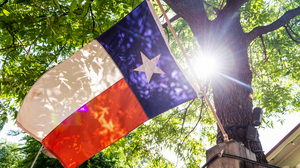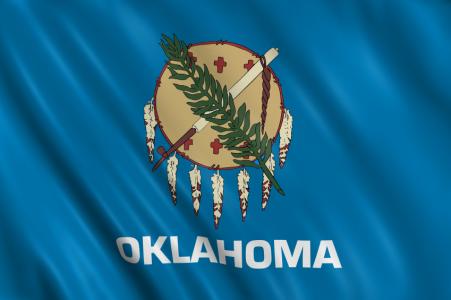
San Jacinto Day
San Jacinto Day commemorates the Battle of San Jacinto in what is now Harris County, Texas.
Kwanzaa is a week-long holiday honoring African culture and traditions. It falls between December 26 and January 1 each year. Maulana Karenga, an African-American leader, proposed this observance and it was first celebrated between December 1966 and January 1967.
Although Kwanzaa (first day) is not a public holiday, businesses and schools may be closed because it falls on the same date as Day After Christmas Day in 2024, which is a public holiday in 4 states.

A candle stick holding seven candles is symbolic of Kwanzaa in the United States.
©iStockphoto.com/Steve Jacobs
Kwanzaa is a holiday honoring the culture and traditions of people of African origin. It is celebrated by people from a range of African countries and their descendants. Kwanzaa consists of a week of celebrations, which ends with a feast and the exchange of gifts. During the celebrations, candles are lit and libations are poured. A libation is the name given to a ritual pouring of a drink as an offering to a god. During Kwanzaa, a wooden unity cup is used to pour the libations.
A Kwanzaa ceremony often also includes performance of music and drumming, a reflection on the Pan-African colors of red, green and black and a discussion of some aspect of African history. Women often wear brightly colored traditional clothing. Some cultural organizations hold special exhibitions of African influenced art or performances during the period of the celebrations.
Originally the people observing Kwanzaa did not mix any elements of other festivals into their celebrations. However, in recent years, it has become increasingly common for people to mix elements of Kwanzaa with Christmas or New Year celebrations. For instance, a family may have both a Christmas tree and a Kwanzaa candle stick on display in their home. This enables them to include both Christian and African inspired traditions in their lives at this time of year.
Apart from New Year's Day (January 1), the days on which Kwanzaa falls are not public holidays. It is largely a private celebration observed by individuals, families and local communities. However, it falls between Christmas and New Year's Day, when some businesses and organizations may be closed or run fewer services. If you need to do business with a company or organization with an African-American orientation during this period, it may be wise to check whether they are open as usual.
The main symbols of Kwanzaa are a mat, on which to put the things needed for the celebration, the unity cup used to pour libations, a candle stick holding seven candles, the seven candles, ears of corn, the Kwanzaa flag and a poster depicting the seven principles of Kwanzaa. The seven principles of Kwanzaa are: unity; self-determination; collective work and responsibility; co-operative economics; purpose; creativity; and earth.
The colors of Kwanzaa are red, black and green. The Kwanzaa flag consists of three blocks, one in each of these colors. Three of the seven candles are red, three are green and one is black. Each candle represents one of the principles of Kwanzaa. The candle holder is carved from a single piece of wood and its shape was inspired by the form of the Ashanti royal throne.
Kwanzaa was first celebrated in December 1966 and January 1967. The holiday was proposed by Maulana Karenga to give those of African descent a holiday to celebrate their own cultural heritage and the key values of family and community. Although seen as an alternative to Christmas and thus possibly anti-Christian in the early years, many people now observe aspects of both festivals.
In 1997 and 2004, the United States Postal Service honored Kwanzaa by issuing stamps depicting an aspect of the festival. In 1997, the stamp was designed by Synthia Saint James and showed an African-American family observing the celebrations. In 2004, the stamp was designed by Daniel Minter and shows seven figures representing the seven principles of Kwanzaa. Kwanzaa gained popularity quite quickly. It is now estimated that about 13 percent of African-Americans (nearly five million people) celebrate the festival in some way.
| Year | Weekday | Date | Name | Holiday Type |
|---|---|---|---|---|
| 2019 | Thu | Dec 26 | Kwanzaa (first day) | Observance |
| 2020 | Sat | Dec 26 | Kwanzaa (first day) | Observance |
| 2021 | Sun | Dec 26 | Kwanzaa (first day) | Observance |
| 2022 | Mon | Dec 26 | Kwanzaa (first day) | Observance |
| 2023 | Tue | Dec 26 | Kwanzaa (first day) | Observance |
| 2024 | Thu | Dec 26 | Kwanzaa (first day) | Observance |
| 2025 | Fri | Dec 26 | Kwanzaa (first day) | Observance |
| 2026 | Sat | Dec 26 | Kwanzaa (first day) | Observance |
| 2027 | Sun | Dec 26 | Kwanzaa (first day) | Observance |
| 2028 | Tue | Dec 26 | Kwanzaa (first day) | Observance |
| 2029 | Wed | Dec 26 | Kwanzaa (first day) | Observance |
While we diligently research and update our holiday dates, some of the information in the table above may be preliminary. If you find an error, please let us know.

San Jacinto Day commemorates the Battle of San Jacinto in what is now Harris County, Texas.

On Confederate Memorial Day remembers the soldiers who died fighting for the Confederate States of America during the American Civil War (1861-1865). It is a state holiday in some parts of the United States.

Oklahoma Day in the United States marks the anniversary of the opening of Oklahoma's lands to European settlers.

Passover marks the Israelites' liberation from slavery and their exodus from Egypt around 3000 years ago.